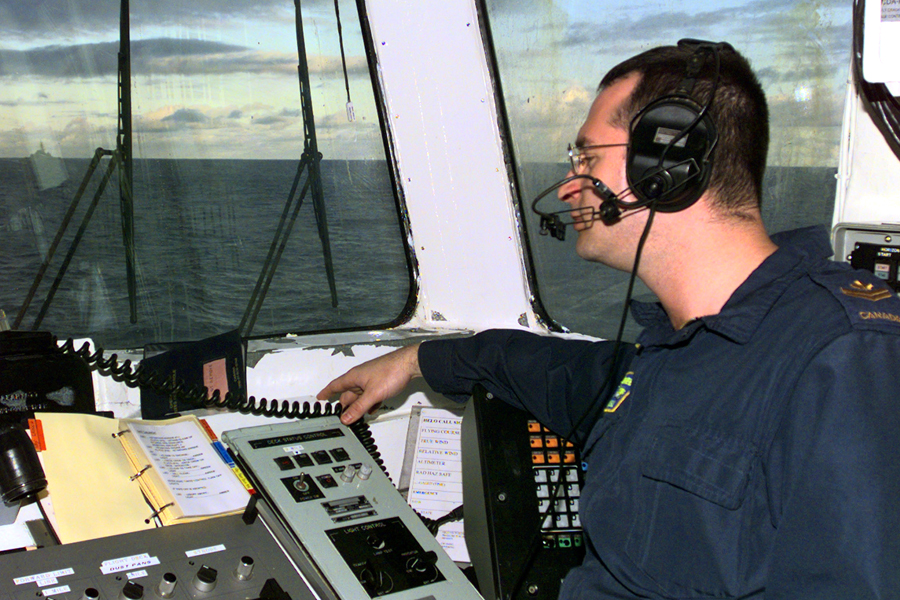Marine technicians take on crash rescue
By Lookout on Nov 05, 2017 with Comments 0

Master Corporal Phil Groleau, a fire fighter from HMCS Algonquin, works as FLYCO on board HMCS Winnipeg. Photo by Corporal Dave Payne
Major Jim Hutcheson, RCAF PA ~
In January 2014, a joint Royal Canadian Air Force (RCAF) – Royal Canadian Navy (RCN) initiative was launched to transfer the vital role of helicopter crash rescue firefighting (HCRFF) on board RCN ships from fire fighters to hull technicians.
The aim was to improve personnel efficiency, given Defence Renewal targets and the reduced crew space available on new ships.
Since that time, Phase I of the transition has progressed smoothly and ahead of schedule. Hull technicians at the ordinary seaman/leading seaman levels have been fully trained and qualified to the required helicopter crash rescue firefighting standards, and they have now assumed this operational role on board all Her Majesty’s Canadian Ships.
The initiative has recently entered Phase II, in which the sector commander (a master corporal) and flying coordinator (FLYCO) (a sergeant) leadership positions will be transitioned to the RCN. Adding to the complexity of the transition, the hull technician occupation is ending and personnel transferred to a new marine technician (MAR TECH) occupation that will incorporate the helicopter crash rescue firefighting skills and training. This will actually benefit the transition by providing a greater pool of candidates to assume these duties.
“The RCN is committed to ensuring training requirements for HCRFF, sector commander and FLYCO are maintained during the transition to the MAR TECH occupation,” said Chief Petty Officer First Class Earl Weir, previously a marine technician occupation manager in Halifax, Nova Scotia.
Chief Warrant Officer Gerard Slaunwhite, from the Office of the Canadian Forces Fire Marshal (CFFM), has been impressed by the progress of the transition.
“The leading seaman crash rescue operations training and the petty officer 2nd class/master seaman FLYCO mentorship have both been going very well,” he said. “Our next step is to get the petty officers second class/master seamen qualified for ship without an air detachment operations. We have been right on course so far, and we will continue to work hard to ensure smooth sailing for the remainder of the transition.”
The added value an HCRFF-qualified MAR TECH brings is an enhanced systems knowledge of the ship, says Major Norman Hanley, Sea Training (Atlantic) air officer.
“They immediately understand the impact of losing certain systems, and have the knowledge to keep the ship and helicopter combination an effective fighting force. As we prepare for operations with the highly advanced [CH-148] Cyclone, the right HCRFF training and infrastructure are vital to help ensure a safe and effective transition for both ship and helicopter crews.”
Over the next two years, the change will be completed on a ship-by-ship basis as personnel become fully trained. Verification of full operational readiness will be conducted as ships perform their Intermediate Multi-Ship Readiness Training.
Close cooperation and coordination between the RCAF, RCN, Director Air Personnel Strategy and the Office of the CFFM have been essential to this initiative. It is important to note that all relevant tactics, techniques and procedures remain consistent, and that the required training levels and standards are met as the role is transferred to MAR TECHs. This initiative will also enhance the health and sustainability of the fire fighter occupation by allowing it to focus on primary land-based duties. The RCN will benefit by more efficiently utilizing crew members in the restricted shipboard environment.
Filed Under: Top Stories
About the Author:





